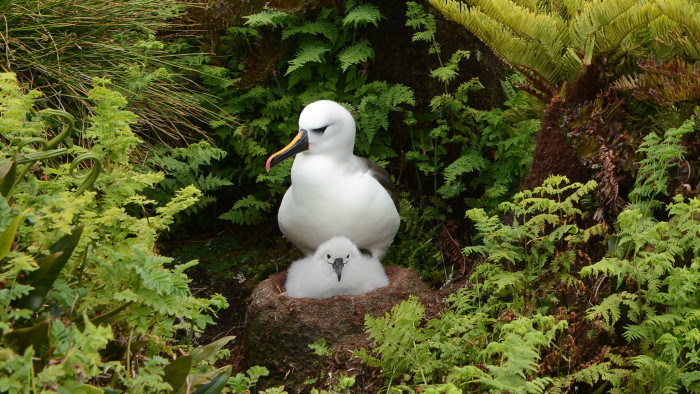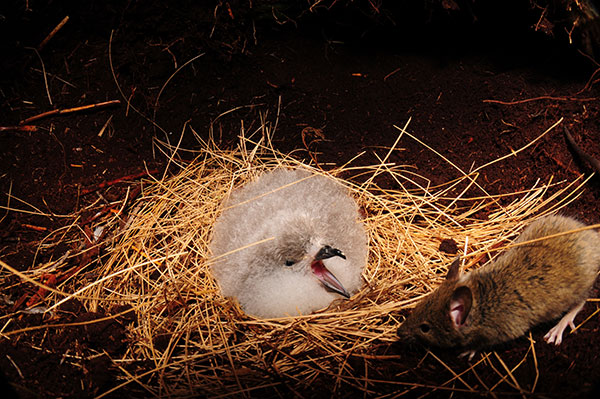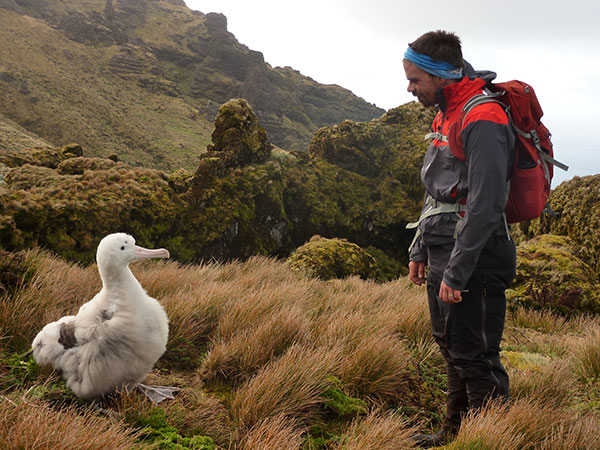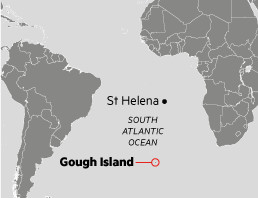The killer mice of Gough Island

Simply sign up to the Life & Arts myFT Digest -- delivered directly to your inbox.
In 2001 two ornithologists working on Gough Island, a remote seabird colony in the South Atlantic, noticed a disturbing pattern. As they investigated the poor breeding success rates of the endangered Tristan albatross and the Atlantic petrel, the researchers came across a number of large chicks with gaping wounds. It looked as though a vicious predator had attacked the birds.
Gough Island, a place of rugged mountains and precipitous cliffs that is uninhabited apart from a small weather station, is home to only one terrestrial mammal: a strain of house mice, thought to have escaped from the ships of seal hunters in the 19th century. It had been thought that the invasive mice had little impact on seabirds but it soon became clear to the researchers, Richard Cuthbert and Geoff Hilton, from the Royal Society for the Protection of Birds, that this view needed to be revised. The descendants of the original stowaway mice were eating alive the chicks of two dozen bird species on Gough, some of which breed nowhere else on earth.
In 2004, a team including Cuthbert and Hilton used infrared cameras to film groups of mice attacking large albatross chicks over several nights. The chicks were up to 300 times heavier than the mice, the team noted, but, astonishingly, this did not discourage the rodents.
This avian horror story has continued to unfold to devastating effect. Today, at least a million voracious mice are thought to inhabit the speck of British territory just 65 sq km in area. Thanks to the abundance of food and lack of predators, the rodents have evolved rapidly since they arrived more than 100 years ago. They grow twice as fast and twice as big as their house-mouse ancestors, with an average weight, 35g, that is 50 per cent above that recorded in wild mice anywhere else in the world. The albatrosses and petrels are defenceless against them, probably because they evolved on islands without any terrestrial mammals and, therefore, have failed to develop “appropriate behavioural responses” to their attackers, according to ornithologists.
Islands occupy less than 6 per cent of the world’s land surface yet they are home to almost 40 per cent of critically endangered species — and 60 per cent of recorded extinctions have taken place on islands, with alien species implicated in most cases.
Alex Bond, a senior conservation scientist at the RSPB, has made several long visits to Gough Island over the past few years and, with RSPB colleagues, has come up with a strategy that he hopes will save the endangered birds from extinction. Together with the UK overseas territory of Tristan da Cunha — the archipelago to which Gough Island belongs — the RSPB plans a £7.6m programme to eradicate the mice. “We estimate that we can save 600,000 chicks a year that are now eaten by mice and prevent the threatened extinction of several species that breed exclusively or almost exclusively on Gough,” says Bond.
To exterminate the mice, the island will be bombarded from the air with a rodenticide, brodifacoum, mixed into cereal pellets. Four helicopters will spread the bait between June 2019 and August 2019 — the earliest feasible date to raise funds and arrange logistics for the operation. Intensive monitoring for any surviving mice will follow, with the RSPB hoping Gough could be declared rodent-free by 2021.
. . .
“Rodent-eradication has become an accepted part of the conservation toolbox,” says Bond. But few campaigns have taken place on terrain as isolated or as hostile as Gough. All staff, equipment, bait and helicopters will have to be shipped 2,800km from South Africa to two bases on the island. Fortunately, there are some encouraging precedents. The best examples of eradications under conditions similar to Gough are on Australia’s Macquarie Island, 1,700km south-east of Tasmania, and Britain’s South Georgia in the far South Atlantic.

On Macquarie, once infested with introduced rabbits, rats and mice, a seven-year campaign of aerial poisoning ended in 2011 after 300 tonnes of bait had been dropped. Human observers and trained rodent-detecting dogs monitored the island for three years without finding a single remaining mammal, and the project was declared a success in 2014. Since then, seabirds have returned to areas where rat predation had previously made breeding impossible, native vegetation is rebounding and even spiders and moths are multiplying.
The South Georgia campaign, billed as “the world’s largest rat-eradication project”, dropped 330 tonnes of bait in three phases over 100,000 hectares of sub-Antarctic wilderness. The poisoning finished in March 2015 and, though monitoring for rodent survivors continues, the project leader Tony Martin is encouraged by the absence of rats since then.
“All the sightings so far have been false alarms — except for one,” says Martin, professor of animal conservation at Dundee University. “That was a rat that unfortunately came ashore in the snow from a government ship. It was tracked down but the episode has reminded everyone that extreme care must be taken to prevent rodents re-invading South Georgia.”
Although populations of some slow-breeding seabirds take many years to recover from rodent predation, the island’s two other native species, the South Georgia pintail duck and South Georgia pipit, a songbird, are already blossoming.
“A British wildlife leader told me yesterday that he sat down and cried with pleasure when he saw a group of 176 South Georgia pintails,” says Martin. “He also saw around 15 South Georgia pipits, their tinkling songs drowning out the noise of the king penguins. We can say that the native wildlife is bouncing back remarkably fast now that the invaders have gone.”
The £7.5m spent at South Georgia is very close to the planned budget for Gough. Although South Georgia covers a much larger area, the campaign there was helped by the fact that the island is divided into three zones by glaciers that rats could not cross. Therefore, eradication could be carried out in three independent stages in different years.
The difference between rats and mice is important, too, when it comes to eradication. “Mice have smaller home ranges than rats and do not travel so far for their food,” says Martin. “Gough has deep ravines and they will have to put the bait into every nook and cranny to make sure the mice eat it.”

. . .
All rodent-eradication projects have to face up to the risk of poisoning native species as a side effect. Fortunately, most seabirds do not eat cereal bait, though a few, such as gulls and skuas, may scavenge on the toxic bodies of dead rats or mice. In some campaigns on other islands birds have suffered a short-term decline for this reason — the worst example was the 2008 rodent-eradication on Alaska’s Rat Island — but they have benefited in the longer run from the elimination of alien predators.
On Gough Island, bait will be dropped during the southern winter, the season when the mice are hungriest but also when birds are likely to be away at sea. Unfortunately, two resident land species of bird have nowhere else to go. “We suspect that the buntings and the moorhens, which eat almost anything, are likely to be affected,” says Bond.
The solution will be to capture substantial numbers of both species and hold them in large aviaries for several months, until the bait has disappeared and the island is once again safe for their release. The RSPB plans to work out details of this logistically demanding operation in collaboration with other conservation bodies and London Zoo.

If the campaign succeeds, Gough will join a growing list of islands liberated by humans from pests that our ancestors introduced generations ago. In March, Proceedings of the National Academy of Sciences published what the authors said was the first global study of invasive mammal eradications. They found overwhelming ecological benefits, with 596 populations of 236 native species on 181 islands gaining ground — and just eight populations of seven species suffering — as a result of the campaigns.
“Invasive alien species are causing an extinction crisis on the world’s islands but our research shows that this is one problem which we have the tools to tackle,” says Stuart Butchart, head of science at BirdLife International, a global not-for-profit group.
At some point in the future it may be possible to rid islands of invasive rodents through “gene drive” technology — editing mouse or rat DNA to make the rodents give birth only to male offspring, which could wipe them out quickly without toxic side effects. But, for the moment, poisoning is the only option, Bond says. “Gene technology may have great potential but we can’t wait for it to be developed and trialled in the field. We know that aerial spreading of rodenticide works and we want to give ourselves the greatest chance of success to save 600,000 seabird chicks a year on Gough.”
Clive Cookson is the FT’s science editor
Photographs: Ben Dilley; Mark Dagleish
Comments